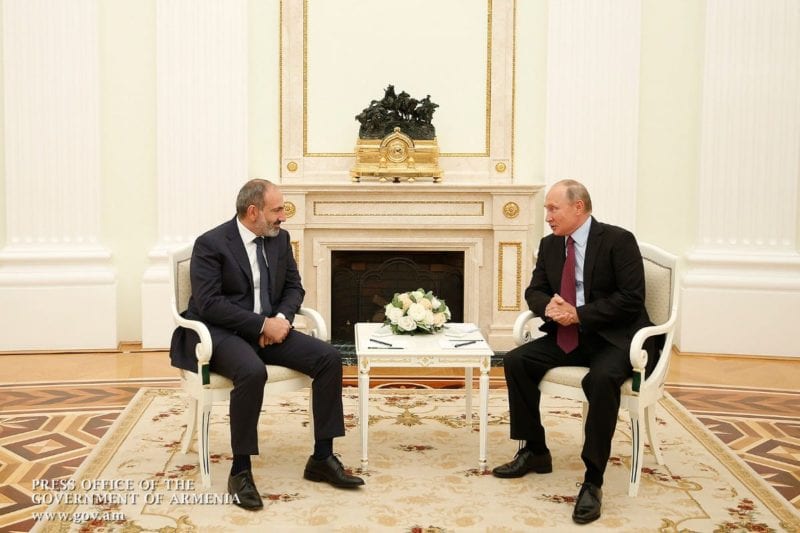 Courtesy: Armenian Government
Courtesy: Armenian Government
A Roadmap to the Future of Armenian-Russo Relations
Russia and Armenia performed joint military exercises through October 14. Yet despite the cooperative appearance of these exercises and the friendly rhetoric coming from the leadership of both countries, Russo-Armenian relations are likely to assume a tone similar to Russo-Belarussian relations. That is, the relationship will feature its own ups and downs but is ultimately guided by the smaller power’s dependency on Russia. The direction of Armenian-Russo relations is illustrated by Prime Minister Nikol Pashinyan’s stance on the Nagorno Karabakh Conflict and the contradictions within official and unofficial reports about the interactions between Moscow and Yerevan.
Though the current joint military exercises are nothing new for the pair, they come at a time where Russo-Armenian relations need public displays of unity in the name of mutual security interests. In the past several months, we have observed public disagreements between Moscow and Yerevan. For example, early in July, Russia’s Minister of Foreign Affairs, Sergey Lavrov, expressed discontent when Yerevan issued an arrest warrant for former Armenian President Robert Kacharyan. Pashinyan then responded to Lavrov’s remarks by suggesting that all partners, including the Russian Federation, should adjust to Armenia’s new administration. Afterwards, Pashinyan downplayed Russia’s mediation mission in the Nagorno Karabakh conflict, and he was also accused of alienating foreign investors in Moscow in September. These reports show new challenges to Russo-Armenian relations after the Velvet Revolution, and demonstrate that Russo-Armenian relations are likely to take a similar tone to Russo-Belarussian relations.
A newfound similarity to Russo-Belarussian relations explains the recent conflicting interactions between Moscow and Yerevan. In this scenario, Pashinyan will attempt to play Europe and Russia against each other while remaining in Russia’s sphere of influence. A growing similarity to Russo-Belorussian relations implies more displays of disagreements with Moscow for the benefit of Armenia’s political leadership and perhaps Armenia’s position. Regardless of this possibility and contrary to the fear that Russia and Armenia’s relationship would dissolve with Pashinyan’s rise, the events of recent months have indeed confirmed a reassurance in commitment to Moscow, despite public displays of disagreements. A Russo-Belarussian type relationship will serve to limit Armenia’s actions and rhetoric due to its dependence on Russia.
With neighbors such as Azerbaijan and Turkey, Armenia has perceived its very own survival as a nation in danger, and that mindset leads it closer to Russia. Overall, Armenia and Russia have always had a unique relationship based on Armenia’s dependence on Russia. Pashinyan knows this, which is why he assured his commitment to Russia’s regional collective security organization and the Eurasian Economic Union, despite his previous criticisms. Four months ago, he also informed President Vladimir Putin in Sochi that he wanted to develop closer ties with Moscow.
Pashinyan has also strengthened his position on Armenia’s claims in the Nagorno Karabakh conflict. His expressions on Nagorno Karabakh and security issues are important because Armenia is highly reliant on Russia for defense and deterrence issues. Russia is Armenia’s line of credit for weapon sales, while Armenia serves as Russia’s strongest ally in the South Caucasus. Armenia also hosts Russia’s 102nd military base from which Russian border guards defend the line between Turkey and Armenia. As for energy security, Russia also provides Armenia with extremely low gas prices that remain at $150 per thousand cubic meters.
In conclusion, the events that unfolded in Armenia have not resulted in any significant foreign policy changes. Armenia’s prioritization of its claim in the Nagorno Karabakh conflict and the history it has with its neighbor, Turkey, inevitably leave it dependent on Russia. Overall, Armenia’s velvet revolution and its consequences will not pose a serious threat to Russo-Armenian relations or Russia’s policies in its near abroad. Despite all of this, Armenia’s trajectory gives us a unique precedent as to how Russia interacts with its post-soviet neighborhood when it comes to color revolutions in contrast to the events in Ukraine and Georgia.





